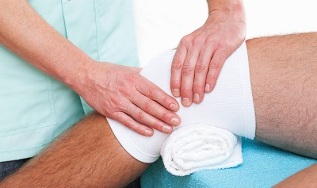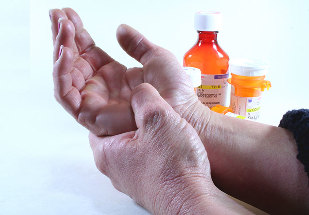The most common joint pathologies are arthritis and osteoarthritis. Both diseases have many differences, on which the outcome of the disease depends a lot. Accurate definition of the disease by a medical specialist is the key to effective treatment for complete healing of the affected joints. Under the influence of age-related changes, every person has a risk of pathological changes in the joints. The joints, which are subject to increased stress throughout life, are particularly affected. Diseases can be a direct cause of joint changes. To prevent undesirable consequences from diseases of the joints, it is necessary to prevent the development of the disease, adhering to prevention and treatment measures.
Main differences between arthritis and osteoarthritis
Joint pathologies: arthritis and osteoarthritis negatively affect the patient's quality of life. The process of causing disease in the joints causes pain and restriction of movement. Both diseases lead to devastating changes in articular structure, but differ in the nature of the origin and course of the disease.
Arthritis, if we compare it with osteoarthritis, is an acute or chronic inflammatory pathology of the joints, which can appear with infections or diseases of an autoimmune nature, become a complication after an injury and also occur in case of reactions. allergic.
Single and multiple nodes are affected. In addition, the inflammatory process spreads throughout the body, including the internal organs in the process.
Osteoarthritis is a process of cartilage modification, leading to joint destruction to a complete loss of movement, like arthritis. A pathological process develops in function of age-related changes in the joint tissues, which are aggravated by the patient's excess weight, metabolic disorders and pathologies of the endocrine system.
The causes of arthritis and osteoarthritis vary considerably. The only unifying factor is the similarity of some symptoms and the miserable result of untreated forms.
Causes of arthritis:
- development of inflammation of the knee joint tissue after trauma of various nature;
- knee infection with viral, fungal and bacterial etiology;
- severe allergies;
- prolonged exposure to cold air;
- lack of vitamins and minerals;
- hereditary predisposition.
The onset of osteoarthritis varies from arthritis to the inevitability of changes in any person of any age. By knowing the etiology of the disease, even at a young age, it is possible to adjust diet and lifestyle to prevent pathology.
Development takes place under the following conditions:
- Wearing
- articulation components comes from aging;
- increased body weight significantly increases the daily load on the knees;
- deforming disorders due to injury;
- malnutrition; Osteoarthritis can be a complication of arthritis, or more precisely of inflammation, which is present in this disease;
- autoimmune pathologies of unexplained etiology;
- congenital pathologies associated with nodules;
- violation of trophism and articular blood supply;
- thyroid gland dysfunction;
- change in hormonal levels;
- polluted environment.
Difference Characteristics
These two diseases sound similar, but differ in many ways. Among the young population, up to forty years old, arthritis is more common, and the destructive processes of cartilage tissue affect the elderly, and the older the person, the higher the risk of disease.
Osteoarthritis is a disease that is localized mainly in the joints, without spreading to the surrounding organs and tissues. Arthritis can be one of the manifestations of a more serious disease involving the whole body in the inflammatory process. Both diseases can occur in acute and chronic forms, only osteoarthritis develops for a longer time and can lead to complete destruction of the joints.
Arthritis has brighter symptoms, accompanied by external manifestations characteristic of inflammation: hyperemia in the area of localization of the process, pronounced swelling, hot skin in the area of the affected joint, pain syndrome. Osteoarthritis continues more smoothly, without spreading beyond the joint. Arthritis, in contrast to osteoarthritis, most often involves small joints during the process: hands, feet, wrists and ankles. The disease rarely affects one joint, polyarthritis is a more common form, and osteoarthritis is localized to large joints.According to statistics, middle-aged men are more likely to develop joint pathology from infections and viruses. The processes that deform the nodes are most common in the female population during menopause, mainly after the age of fifty. Children can also be exposed to joint damage, especially juvenile arthritis is considered dangerous, which can cause limitation.
Signs of manifestation
important it is important to seek medical advice at the first symptoms for a successful recovery and restoration of the joints for optimal motor activity. Arthritis and osteoarthritis differ significantly in the initial period of the disease. Inflammation is manifested by the severity of the symptoms, for which it is easy not to miss the onset process.
Dystrophic changes in the wrist tissue are poorly manifested in the initial stage, so patients often come to the orthopedist when the disease is in the second or third stage of development. In this case, the treatment is complicated, lasts a long time and requires many measures to restore the normal functionality of the joints. A slow process is difficult to diagnose on your own, but for any manifestation of joint discomfort, you just need to go to the doctor’s office so as not to miss the initial stage of the disease.
How does arthritis appear?
- In contrast to osteoarthritis, with arthritis, swelling appears around the inflamed joint, impeding movement and causing a lot of discomfort when moving independently.
- In acute inflammation, the skin at the joints becomes hyperemic and hot to the touch.
- If arthritis is of the type caused by an infection. The general condition of the patient suffers, intoxication begins, which is accompanied by a thirsty state.
- A stabbing pain appears in the inflamed joints, which tends to increase significantly with movement. In a relaxed state, the pain syndrome does not subside but becomes pulsating.
- In most cases, arthritis is accompanied by a general worsening of the condition, weakness appears and chronic diseases worsen.
- The most vulnerable are the knuckles of the hands and feet, as well as the ankle and hand.
Symptoms of Osteoarthritis
Manifestations of osteoarthritis have no characteristic signs in the first years of the disease, the ear joint makes itself felt after several stages of development of the pathological condition.Signs of osteoarthritis:
- pain does not appear immediately, the pain increases as the condition of the joint worsens;
- in the absence of movement, pain does not arise, pain syndrome begins to develop with activation;
- in case of hip or knee joint damage - gait becomes smooth and range of motion is incomplete;
- in neglected conditions, shortening of the lower limb may occur, in the absence of correction, spinal pathologies develop;
- when cartilage tissue is destroyed, the joint loses movement and a complete blockage of the joint occurs;
- pronounced crepitus in the joint during physical activity.
How to treat diseases?

Arthritis and osteoarthritis differ markedly in the approach to treatment. Different causes and mechanisms of pathology development suggest the initial establishment of the correct diagnosis in order for therapeutic measures to be effective.
To avoid getting sick and wasting precious time, do not rely on the experience of friends and popular recipes.
Disease processes that have a detrimental effect on the joints should not be allowed to flow. It is important to feel the joy of movement at any age; not only the well-being but also the quality of life of a person depends on it.
Treat arthritis
Treatment should begin with identifying the factors that cause the inflammation. Determining the nature of the origin of the disease, drugs that destroy the pathogen of the pathology are prescribed. When exposed to pathogenic bacteria, the patient is prescribed antibiotics, which, depending on the severity of the intoxication, are prescribed in the form of tablets or injections. Viral lesions are treated with antiviral pills.
The basis for effective removal of inflammation and pain suppression will be the mandatory intake of non-steroidal anti-inflammatory drugs. They will help to cope with the unwanted symptoms, both when taking the pill and the local effects on the diseased joint area.
Strengthening the immune system is the basis for successful disease control. Taking multivitamins with micronutrients will support a weakened body and help turn the disease towards recovery. In addition to synthetic complexes, natural sources of vitamins are also useful - berries, fruits, vegetables.
Proper nutrition and a special diet is indicated for patients with arthritis as well as osteoarthritis. Allowed products include fermented milk products, lean meats, fish, vegetables, herbs. You will need to give up strong coffee and black tea, carbonated and alcoholic beverages.
Physiotherapy and physiotherapy procedures give excellent results in combination with the main therapy: treatment with a pulsed magnetic field, radon baths, electrophoresis and other methods. The list of special exercises is made by a physiotherapist, under whose supervision the load is performed.
We treat osteoarthritis
The disease develops slowly and has a fundamentally different treatment, which should aim at restoring the cartilage tissue of the ankle. A real salvation will be the use of chondroprotectors, which, with prolonged use and following the doctor's recommendations, can prevent the progression of destructive changes and restore damaged cells.
Chondroprotectors support tissue nutrition and promote cartilage repair, as well as an increase in the production of articular fluid, which serves as the sole food source for joint components.
When pain occurs, NSAIDs are recommended for the symptomatic treatment of pain. Fortified food, giving up alcohol and smoking leads to an increase in the body's resistance and an increase in strength to fight for healthy joints.
Therapeutic gymnastics using various methods increases blood circulation to the affected area, causes the joints to move, increasing trophism. Traditional recipes, tested for years, are useful as an additional method of alternative medicine.
In the later stages of osteoarthritis and arthritis, the only solution is surgical treatment of the joint capsule. The most commonly used method is cartilage transplantation, which can restore movement to the affected joint.
How to define a disease?
To determine exactly what disease develops in the joints, you should schedule an appointment with an experienced orthopedist. At the first appointment, the doctor will perform a visual examination and ask questions of interest that will help to form a picture of the disease.
Laboratory blood test results will help differentiate arthritis from osteoarthritis, this will require general and biochemical tests. X-ray examination will help to examine the node in detail from the inside.
In some pathologies, the patient is referred for a magnetic resonance examination, which will answer the doctor's questions regarding the diagnosis of the pathology. After collecting all the results, a diagnosis will be made, which will serve as the basis for prescribing treatment.
Preventive measures
Keeping your joints healthy requires a healthy lifestyle. Proper nutrition and regular exercise will prolong life together, which is important for overall health.
In the smallest manifestations of osteoarthritis or arthritis, under no circumstances should you treat yourself. Improper actions can negatively affect the outcome of the disease. Timely referral to a specialist and further adherence to appointments guarantees successful treatment, which will make it possible to lead a healthy lifestyle.





































